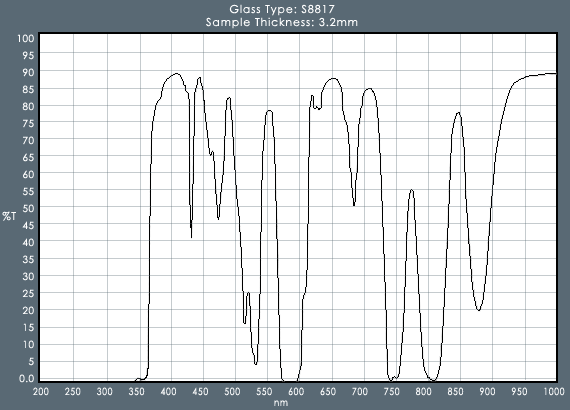 |
 Safety Emporium is a proud sponsor of this site. |
 |
Home Page --> Rose Didymium Glass
|
 |
 Safety Emporium is a proud sponsor of this site. |
 |
Home Page --> Rose Didymium Glass
|
This information is provided courtesy of Phillips Safety Products
Rose didymium is a high luminous transmittance filter specifically designed to absorb bright yellow sodium flare (589 nm) which occurs when heating glass. Didymium lenses protect the eyes from certain visible and UV light produced in the glassblowing process. They enable the glassblower to see the glass while it is being worked in the flame.
This is the classic filter that has been used for many years in all types of hot glass applications, as well as kiln working. The lens is dichromic (exhibits different colors under various light sources). Under incandescent light, the lens is a pronounced rose color, but changes to greenish blue under fluorescent light.
The spectral analysis of this glass at 3.2 mm thick indicates that it has good protection against ultraviolet radiation up to 360 nm, has excellent filtration at the sodium line, and excellent overall visible transmission from 400 nm to 725 nm. The glass does not offer much protection in the near or mid infrared ranges.
In general, this lens is adequate for many glass-working applications where the amount of radiation generated is low.
Suggested uses: Beginning lamp-work using hot head torches and MAPP gas, or propane torches with soft glass. Periodically viewing small kilns, acetylene torch work on solver and gold jewelry, enameling of jewelry, and operation requiring occasional viewing of heat sources in excess of 1000 degrees, but not for use with high pressure torches on hard materials where very high temperatures are generated.
Liability Disclaimer: Phillips Safety Employees are not optometrists and can only make suggestions concerning eye protection. There are many types of eye protection available and we manufacture as many as possible. Phillips Safety Products does not accept any liability concerning eye damage arising from the use, misuse, or non-use of any eyewear products we sell.
Schott Glass Technologies has developed a new contrast enhancement glass for spectacle lenses. The new material, called ACE, short for "Amethyst Contrast Enhancer," utilizes rare earth oxides in the glass composition to achieve the unique color enhancing characteristics.
Basically, the color enhancement concept works by selectively positioning transmission in the blue, green, and red spectral regions whereby one can improve the color discrimination between different color objects. These are the same colors used to produce a color television picture. They optimize the readability of such displays under high ambient light conditions.
Phillips-202 Glass utilizes rare earth oxides in its composition to provide the same filtration. This glass is very efficient in filtering sodium flare in addition to providing ultraviolet protection to 390 mm. The Phillips202 (ACE) is becoming a preferable choice of hot glass workers. It is very comfortable for viewing under high ambient light conditions such as when working with hot glass or glowing heat sources for a duration of time. Also, although it has a relatively low luminous transmission of 38%, it is not recommended for sun protection use unless UV filtering coatings are applied.

Liability Disclaimer: Phillips Safety Employees are not optometrists and can only make suggestions concerning eye protection. There are many types of eye protection available and we manufacture as many as possible. Phillips Safety Products does not accept any liability concerning eye damage arising from the use, misuse, or non-use of any eyewear products we sell.
Disclaimer: Glassblowing has inherent hazards that can result in burns, cuts, injuries or even death. While every effort has been made to convey best safety practices, the materials presented herein can not anticipate every possible risk or hazard associated with a given glassblowing activity. The reader is responsibile for assessing and mitigating any and all such hazards or risks before commencing any activity connected with his or her use of these materials. Neither the author nor ILPI assumes responsibility or liability for injuries, losses, claims or damages to the reader or other parties that may result from the use or misuse of these materials.
by Joe Walas and/or ILPI, all rights reserved unless otherwise stated. Unauthorized duplication or posting on other web sites is expressly prohibited. Send suggestions and comments (include the URL if applicable) to us by email.